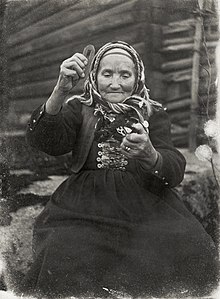Fire striker


Afire strikeris a piece ofcarbon steelfrom which sparks are struck by the sharp edge offlint,chertor similar rock.[1][2][3]It is a specific tool used infire making.
History
[edit]Before the invention of matches, percussionfire makingwas often used to start fires. Before the advent of steel, a variety ofiron pyriteormarcasitewas used withflintand other stones to produce a high-temperature spark that could be used to create fire.[4]There are indications that the Iceman, also known asÖtzi,may have used iron pyrite tomake fire.[5]
From theIron Ageforward, until the invention of the frictionmatchin the early 1800s by John Walker, the use of flint andsteelwas a common method of fire lighting. Percussion fire-starting was prevalent in Europe during ancient times, theMiddle Agesand theViking Age.[3][6]
When flint and steel were used, the fire steel was often kept in a metaltinderboxtogether with flint andtinder.InTibetandMongolia,they were instead carried in a leather pouch called achuckmuck.
In Japan, percussion fire making was performed using agate or even quartz. It was also used as a ritual to bring good luck or ward off evil.[7][8]
Uses
[edit]
The type and hardness of steel used is important.High carbon steels(1060, W1,tool steels,etc.) generate sparks easily.Ironandalloys(likestainless steel,5160, etc.) are more difficult and generate fewer sparks. The steel must be hardened but softer than the flint-like material striking off the spark.[9]Old files, leaf and coil springs, and rusty gardening tools are often repurposed as strikers.
Besides flint, other hard, non-porous rocks that can take a sharp edge can be used, such aschert,quartz,agate,jasperorchalcedony.[2]
The sharp edge of the flint is used to violently strike the fire steel at an acute angle in order to cleave or shave off small particles of metal. Thepyrophoricityof the steel results in the shavings oxidising in the air. The molten, oxidising sparks then ignite tinder. The tinder is best held next to the flint while the steel striker is quickly slid down against the flint, casting sparks into the tinder.Char clothoramadou( "tinder fungus" ) is often used to catch the low-temperature sparks, which can then can be brought to other, heavier tinder and blown into flame.
See also
[edit]- Chuckmuck
- Coat of arms of Serbia(uses fire striker symbols as charges)
- Fire piston
- Ferrocerium
- Order of the Golden Fleece(whose collar consists of firesteels linked by flints)
References
[edit]- ^Bush, Darren."Traditional Firestarting Part I: How to Make Fire with Flint and Steel".Manly Skills, Self-Reliance, Survival.Art of Manliness.Retrieved27 July2015.
- ^ab"Do you have 5 Ways to Make Fire?".Survival Cache.Retrieved27 July2015.
- ^ab"Fire from Steel - Custom forged fire steels from Roman through Fur Trade time periods".Angelfire.Retrieved2013-07-21.
- ^"Flint and Marcasite Fire Making".
- ^"Ötzi, l'Uomo venuto dal ghiaccio".Archived fromthe originalon 2014-02-01.Retrieved2014-01-18.
- ^"Viking Answer Lady Webpage - Viking Age Fire-Steels and Strike-A-Lights".Vikinganswerlady.Retrieved2013-07-21.
- ^Alice (23 December 2010)."Do-it-yourself kiribi".
- ^Gordenker, Alice (16 December 2010)."Kiribi"– via Japan Times Online.
- ^"Materials and Heat Treatment for Fire Strikers".
External links
[edit]
